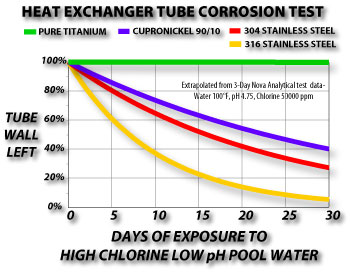 OUR SKIMMER TEST
OUR SKIMMER TEST
Way back in 1983 when the first Heat Siphons used cupronickel heat exchangers and corrosion problems were just beginning to surface, we ran our own corrosion tests to find a tube material to solve our cupronickel corrosion problem.
We tested at 100°F with a pH of 4.75 and chlorine levels 50000 parts per million (10000 times greater than normal pool water). Although this is a severe test, it simulates realistic possible conditions such as chlorine tablets in skimmers and out of balance pool water.
We tested cupronickel, 304 & 316 stainless steels. and other alloys including Titanium.
After 48 hours cupronickel lost 9% of its original weight or wall thickness and 304 & 316 stainless steels corroded even more. After 3 days exposure all three were classified as SEVERELY CORRODED and well on there way to tube wall breach and heat exchanger failure.
The graph shows these results extrapolated to 30 days exposure and the resulting tube wall thinning for each material. As you can see only TITANIUM WILL SURVIVE. In fact if you could see the graph way out after one year of exposure to this severe pool water Titanium will still be at the top of the graph.
ONLY PURE TITANIUM SHOWS VIRTUALLY NO MEASURABLE CORROSION!!
HEAT SIPHON HISTORY - Back in the late 1970's gas pool heaters dominated the pool heating market and used copper tubes in their heat exchangers. In 1983 when the first Heat Siphon was designed, we decided to use cupronickel which was more expensive than copper and much better at resisting chemical corrosion in slightly imbalanced pool water. It only took one year before even cupronickel HAD TO GO!


 RUST ISN'T FREE
RUST ISN'T FREE